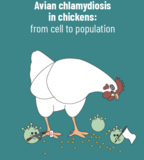Avian chlamydiosis in chickens
from cell to population

Heijne, Marloes
- Promoter:
- Prof.dr M. (Mirjam) Nielen
- Co-promoter:
- Dr A.P. (Ad) Koets & dr J.A. (Jeanet) van der Goot
- Date:
- December 8, 2021
- Time:
- 16:15 h
Summary
Chlamydia gallinacea and Chlamydia psittaci are intracellular bacteria belonging to the Chlamydiaceae family and are a cause of avian chlamydiosis in poultry. C. psittaci was considered the predominant chlamydial species in poultry until C. gallinacea was discovered in 2009. C. psittaci occurs worldwide, is zoonotic and has a wide host range. C. gallinacea is widespread in chickens, and infections appear asymptomatic, but reduced weight gain has been observed in broilers. Studies about the pathogenic potential of C. gallinacea are still limited, and any zoonotic potential has yet to be determined. The aim of this study was to gain insight into the prevalence of Chlamydia in Dutch chickens and to investigate the pathogenic potential of C. gallinacea. In a prevalence study, C. gallinacea was detected in around half of the 151 layer farms, but C. psittaci was not found. Subsequent research into the pathogenic potential of Dutch C. gallinacea strains showed that C. gallinacea mainly infects the mucosa of the chickens’ gut without causing clinical signs of inflammation. Finally, it was investigated whether a previous C. gallinacea infection in chickens could protect against a C. psittaci infection. This could explain why C. psittaci was not found during the field study in layers. However, protection against C. psittaci after a previous infection with C. gallinacea was not shown. In conclusion, Chlamydia infections in Dutch chickens cannot be considered a current One Health problem, but future introductions of C. psittaci cannot be excluded.